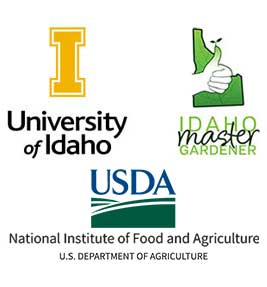2020 Peach Leaf Curl Detected
Swipe Left or Right to navigate Alerts
2020 Peach Leaf Curl Detected
Landscape & Garden Treasure Valley
Peach Leaf Curl (Taphrina deformans)
Posted on: May 4, 2020 by Nic Usabel
The Master Gardeners operating the University of Idaho Extension, Canyon County plant diagnostic clinic have identified samples of peach leaf curl. Peach leaf curl is caused by a fungus (Taphrina deformans) and there are no management options after infection has set in. Dispose of symptomatic leaves which fall to the ground. Control can be achieved in the fall with a single application of fungicides after 90% of leaves have fallen. A follow-up alert with control options will be sent in the fall.
Spores of this fungus overwinter on bark, twigs, and old infected leaves. Infection occurs through bud scales in mid- to late winter just as buds begin to swell. Slow growing shoots and leaves can be infected during cool and wet growing seasons. Maximum susceptibility is between bud break and petal fall.
» https://pnwhandbooks.org/plantdisease/host-disease/peach-prunus-persica-leaf-curl
» https://digitalcommons.usu.edu/cgi/viewcontent.cgi?article=1736&context=extension_curall
»
peach leaf curl1
»
peach leaf curl2
»
peach leaf curl3
2020 Peach Leaf Curl Detected
Landscape & Garden Treasure Valley
Peach Leaf Curl (Taphrina deformans)
Posted on: May 4, 2020 by Nic Usabel
The Master Gardeners operating the University of Idaho Extension, Canyon County plant diagnostic clinic have identified samples of peach leaf curl. Peach leaf curl is caused by a fungus (Taphrina deformans) and there are no management options after infection has set in. Dispose of symptomatic leaves which fall to the ground. Control can be achieved in the fall with a single application of fungicides after 90% of leaves have fallen. A follow-up alert with control options will be sent in the fall.
Spores of this fungus overwinter on bark, twigs, and old infected leaves. Infection occurs through bud scales in mid- to late winter just as buds begin to swell. Slow growing shoots and leaves can be infected during cool and wet growing seasons. Maximum susceptibility is between bud break and petal fall.
» https://pnwhandbooks.org/plantdisease/host-disease/peach-prunus-persica-leaf-curl
» https://digitalcommons.usu.edu/cgi/viewcontent.cgi?article=1736&context=extension_curall
»
peach leaf curl1
»
peach leaf curl2
»
peach leaf curl3



